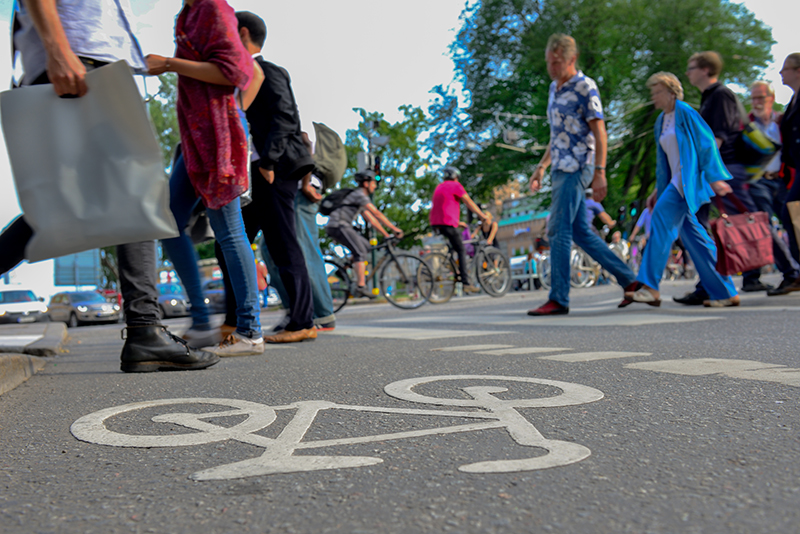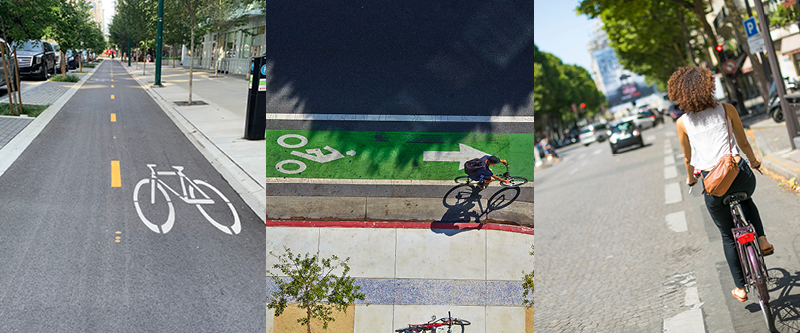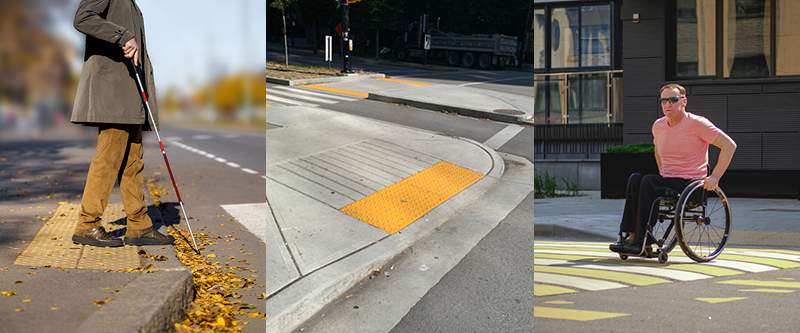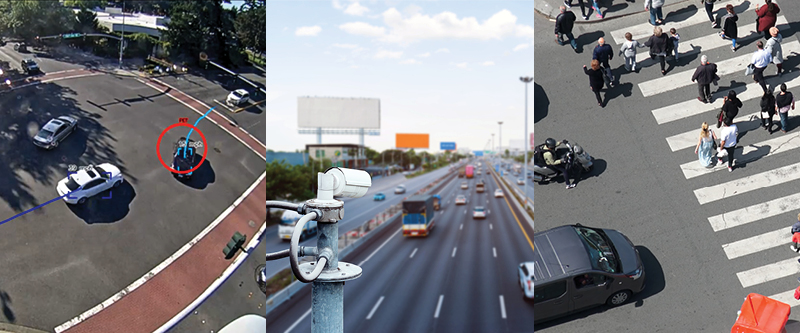In parts one and two of our three-part series on improving traffic safety for all, we looked at the increase of road traffic crashes and surveyed some of the system approaches to making roads safer, especially for vulnerable road users. In part three, we examine some of the tools that transportation professionals can use to implement the Safe System and Complete Streets approaches.

As road transportation professionals worldwide focus their attention on making streets safer for all, a key part of their work is ensuring the safety of vulnerable road users (VRUs).
Vulnerable road users such as pedestrians, cyclists, and wheelchair users have little to no protection from crash forces—making them more likely to be seriously hurt or killed when impacted by a vehicle. They include people with disabilities who use mobility aids as well as those with reduced mobility, such as the elderly, young children, and people using strollers. Cyclists include the growing number of road users on devices like electric bikes and e-scooters.
VRUs face unique challenges. Cyclists often lack dedicated lanes, meaning they must travel among faster-moving vehicles and are at risk of parked cars suddenly opening doors. Pedestrians may have to travel in areas lacking sidewalks or along poorly designed footpaths, navigate across busy streets using inadequate street crossings, or walk distances without sufficient shade or shelter. For wheelchair users, barriers include inaccessible curbs, narrow sidewalks, obstructions such as poles or misplaced signboards, and surfaces that are uneven or hard to move on.
In addition to increasing VRUs’ risk of being involved in a crash, non-inclusive road design may discourage VRUs from using certain modes of transportation or from going out altogether, leading to their increased social isolation and reduced physical activity. On a societal scale, the economic impacts go beyond the costs of the crashes themselves; commercial districts can also suffer decreased activity because users avoid going to areas that they find hard to navigate.
How can transportation and traffic planners, engineers, and designers help make streets safer for the vulnerable? Many of the options are relatively affordable and easy to implement. These include installing better signage, high-visibility crosswalk markings, improved street lighting, stop and signal improvements, audible pedestrian crossing signals, and traffic calming measures such as roundabouts, center medians, street trees, and planter strips.
Two basic ways to ensure the safe movement of VRUs are the installation of separated bike lanes and of curb ramps. Computer-aided video technology is also helping transportation professionals proactively decide where improvements that protect VRUs are needed.
Separated bike lanes for cyclist and pedestrian safety

Cities around the world have seen an increase in bicycle ridership, especially with the introduction of electric bikes and other devices like e-scooters. With this increase, many areas have seen a corresponding rise in collisions between vehicles and bicycles. One way to encourage cycling as a form of sustainable transportation and ensure that cyclists, as well as pedestrians, are safer, is to install separated bike lanes.
Adding dedicated bike lanes, separate from sidewalks, and sometimes protected from vehicle lanes by a curb separation, are often a pivotal component of Complete Streets design. A study by the Complete Streets Coalition of 37 Complete Streets projects showed the positive impacts of such projects. Because they help VRUs like pedestrians and cyclists feel, and be, safer, Complete Street areas often see a rise in pedestrian and cyclist activity. This, in turn, can result in increased economic benefits for commercial districts. As well, some Complete Streets areas have seen a 70 percent reduction in collisions; in areas where collisions increased, it was due to a massive, sudden influx (with increases up to 900 percent) of cyclists and pedestrians.
Designing safe bike lanes might seem straightforward, but bicycles come in a variety of shapes and sizes and often use leaning to assist with steering, which influences their turning behaviors. Also, a rider’s body is not protected, meaning that designs must also account for clearances of the rider’s head, and of the handlebars and pedals.
This complexity prompted Transoft to introduce bicycle swept path analysis into its flagship software, AutoTURN Pro. Incorporating 13 different bike styles—including recumbent bikes and bicycles with trailers—with their accurate turning movements, along with established standards and guidelines, AutoTURN Pro helps designers and engineers accurately account for cycle movement and turning in their roadway and bike path designs.
Curb ramps for improved sidewalk accessibility

Transoft has also developed software to help address municipalities’ pressing need to build or retrofit curb ramps for VRUs.
Without adequate and accessible curb ramps, it can be nearly impossible for those with disabilities to cross the street. A curb ramp—cut directly into a curb or building up to it—creates a route from the road to the sidewalk, and vice versa, for those who use wheelchairs or other mobility aids like walkers or scooters. In the absence of ramps, those with disabilities must either risk travelling in the street alongside motor vehicles or stay home. In fact, surveys have shown that many do choose to stay home unless completely necessary, because they assume their destination will be inaccessible.
Curb ramps also make travel easier for other VRUs, including those using strollers or shopping carts, or walking with young children. They’ve proven vital to older adults, who typically move slower, frequently use mobility aids such as walkers or canes, and have eyesight and/or hearing loss, and who often rely on walking and taking transit to shop and to access social networks at places like seniors’ centers.
Since the first curb ramp in the United States in the 1940s, millions of curb ramps have been installed. But in the early 1990s, when curb ramp standards were implemented through the Americans with Disabilities Act (ADA), it became clear that many existing ramps were not compliant. A recent study showed that even today, 65 percent of existing curb ramps in the US are not accessible for people with disabilities, despite the ADA being an all-inclusive, enforceable law.
Yet, while many cities have undertaken street and sidewalk projects to include curb ramps, often by making retrofits to existing infrastructure, others have taken a piecemeal approach, only installing them when there is new construction or when maintenance is necessary. They may be limited not only by the number of curb ramps they can construct, but also by the number they can design or re-design.
For decades, designers and engineers had to use a tedious ‘guess and check’ method to design ADA-compliant ramps, which must meet standards related to a ramp’s width, slope, cross slope, placement, and other features. Such a method required multiple design iterations because every time an adjustment was made, it set off a chain reaction affecting other design variables. Transoft’s AQCESSRAMP is the first-of-its-kind software for the design and retrofitting of sidewalk curb ramps. With it, users can design accurate curb ramps in minutes, using built-in templates of ramp types compliant to existing standards—meaning that cities can more easily tackle the significant backlog of curb ramp installations and retrofits required.
Video analysis to proactively assess risks and evaluate improvements

As part of the Safe System approach advocated for by the United Nations, transportation professionals are encouraged to undertake crash-risk mapping and proactive safety assessment of road networks as part of the operation of safe roads infrastructure.
In the US, the Department of Transportation (DOT) Federal Highway Administration’s guidance on Vulnerable Road User Safety Assessment directs states to also identify areas that are high-risk to VRUs, through the mapping of high collision corridors or through predictive safety analyses of roadway sites with the greatest potential for improvement. The Safe Streets for All (SS4A) program through the US DOT provides grant funding for such activities.
In the past, such assessments were limited to examining historical crash data or conducting in-person site visits to manually count individual road users and interactions—methods that have serious limitations.
With new computer-aided video analysis software, such as TrafxSAFE by Transoft, engineers and planners can swiftly prioritize high-risk locations, identify key crash factors including structural factors and road user behaviors, and assess the effectiveness of safety measures—all before crashes occur.
TrafxSAFE uses advanced AI technology to analyze video footage from existing cameras, or cameras temporarily placed on site, to identify aspects like speeds (of vehicles, cyclists, and pedestrians), traffic patterns like the stopping and turning behaviors of vehicles and crossing behaviors of pedestrians, along with risky interactions, such as potential conflicts and near-misses. It clearly identifies the paths of different types of users, allowing planners to prioritize VRUs in deciding on safety program investments.
These assessments can sometimes generate surprising or new results. For example, in a study of VRUs conducted by Transoft at five sites in Sao Paulo, Brazil, it became clear that many pedestrians were crossing a road at an unmarked site to reach a clinic.
The study used TrafxSAFE to evaluate 30,000 road users over 250 hours of video footage. As part of its methodology, it differentiated between pedestrians with disabilities (those using a wheelchair, walking stick, or crutches, and those with impaired vision using a cane or a support dog) and pedestrians with reduced mobility (those persons with a support person, pregnant women, people with a baby on a stroller, a person holding a baby, or a person with a child holding their hand).
In assessing the speeds of those groups, they found that 50 percent of people with disabilities were not able to cross the street at designed speeds. Also, in general, those with reduced mobility moved as slowly as those with disabilities, yet motor vehicles typically afforded more time and space for crossing to those with disabilities.
The study also confirmed that those pedestrians with disabilities and reduced mobility had a slightly higher risk for vehicle-pedestrian conflict interactions—providing evidence for the implementation of safety measures.
Learn more about Transoft’s suite of solutions to help you design with safety as a primary decision consideration: https://www3.transoftsolutions.com/landing/safety-driven-design